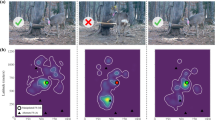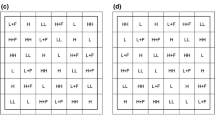Abstract
The notion that spatial scale is an important determinant of foraging selectivity and habitat utilization has only recently been recognized. We predicted and tested the effects of scale of patchiness on movements and selectivity of a large grazer in a controlled field experiment. We created random mosaics of short/high-quality and tall/low-quality grass patches in equal proportion at grid sizes of 2×2 m and 5×5 m. Subsequently, we monitored the foraging behaviour of four steers in 16 20×40 m plots over 30-min periods. As predicted on the basis of nutrient intake maximization, the animals selected the short patches, both by walking in a non-random manner and by additional selectivity for feeding stations. The tortuosity of foraging paths was similar at both scales of patchiness but selectivity was more pronounced in large patches than in small ones. In contrast, the number of bites per feeding station was not affected by patch size, suggesting that selection between and within feeding stations are essentially different processes. Mean residence time at individual feeding stations could not be successfully predicted on the basis of the marginal-value theorem: the animals stayed longer than expected, especially in the less profitable patch type. The distribution of the number of bites per feeding station suggests a constant probability to stay to feed or to move on to the next feeding station. This implies that the animals do not treat larger patches as discrete feeding stations but rather as a continuous resource. Our results have important implications for the application of optimal foraging theory in patchy environments. We conclude that selectivity in grazers is facilitated by large-scale heterogeneity, particularly by enhancing discrimination between feeding stations and larger selection units.
Similar content being viewed by others
Author information
Authors and Affiliations
Additional information
Received: 1 March 1999 / Accepted: 14 July 1999
Rights and permissions
About this article
Cite this article
WallisDeVries, M., Laca, E. & Demment, M. The importance of scale of patchiness for selectivity in grazing herbivores. Oecologia 121, 355–363 (1999). https://doi.org/10.1007/s004420050939
Issue Date:
DOI: https://doi.org/10.1007/s004420050939




